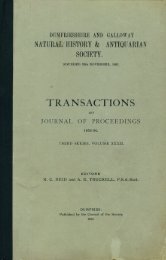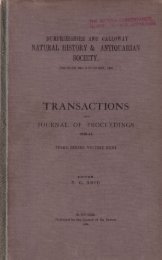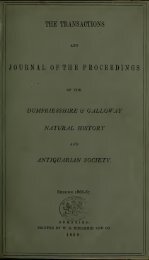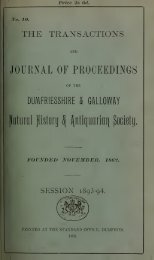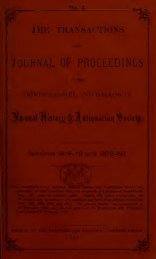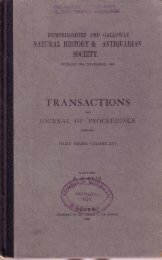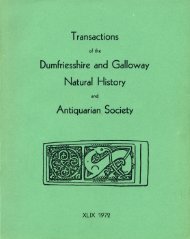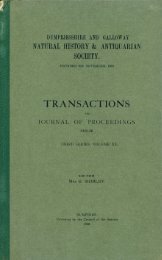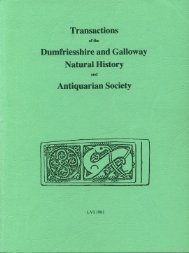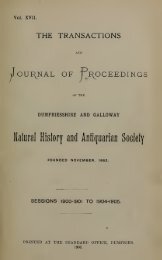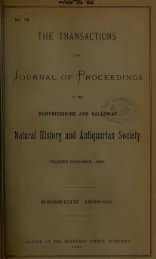54 Transactions.Ll<strong>and</strong>overy.It will be observed that it shows no row of denticlesor hydrothecse as in Monograptus Sagittarius, Linn, M. Nilssoni,Barr, <strong>and</strong> many others, but merely elliptical apertures formingthe cell's mouths on both sides of a cylindrical frond or tube,which are not opposite to each other, but alternate. Its widthwhen fully developed is about one-eighth of an inch. The solidaxis is prolonged both proximally <strong>and</strong> distally to a considerablelength. The external appearance of the frond varies accordingto the amount of pressure it may have sustained. There areabout 30 hydrothecae to an inch. The cylinder or frond ofC'liviacograptus teretiusculus (His.) is made up of two semi-circularcompartments, placed back to back with the septum, <strong>and</strong> thesolid axis placed in the centre forming a mutual gable or partition,as it were, between the two colonies of Zooids, having each theirown row of cells <strong>and</strong> common canal, each colony being quiteindependent of the other. Localities for this species are Dobb'sLinn, Hartfell, Beld Craig, ifec.Genera Didymograpkcs.—The polyjjery is composed of twosimple branches springing bilaterally from the radical or initialpoint. The branches are monopriodon, assuming different anglesin different species. The cells, or " hydrothecse," are generallyopposite to the radical or initial point, but in some examples theyai"e found on the same side. The size of the radical or spinevaries very much in different species, <strong>and</strong> in some it is altogetherawanting. It is not easily determined to wliat uses these spinescould have been applied, as there does not seem to beany evidence that they had been objects of attachment. If welook at their different positions with the spines inside of theangles or concave, one would think it scarcely possible for themto be used for such a purpose, more especially as some of themare without any radical or initial point whatever. The genusDidymograptus was originally founded by M'Coy (1851), <strong>and</strong>takes in those Graptolites which are " bifid," or of a twincharacter. The vertical range of this genus has its commencementin the Skiddaw <strong>and</strong> Quebec groups, <strong>and</strong> attains its maximumin those rocks in which it is represented by numei'ous <strong>and</strong> remarkableexamples.It likewise occurs in the lower Ll<strong>and</strong>eilo, <strong>and</strong> isalso well represented in the upper Ll<strong>and</strong>eilo rocks, but is scarcelyknown in the Caradoc period of this country. Several examplesare got in the rocks of this age in America, but not one is known inthe upper Silurian, <strong>and</strong> it may safely be said to be characteristicof the upper <strong>and</strong> lower Silurian periods.
—TransartionR. 55The genus Didymograptus of the Moffat district, belongs to tlieupper Ll<strong>and</strong>eilo black shales. I have brought several specimensforward to-night, which we may examine.It will be found thatthe cellules are attached to the under or inferior side of the twoarms. It will also be seen that tlie spines are both on the upper<strong>and</strong> lower, <strong>and</strong> some cells are without any whatever.It will alsobe observed that those belonging to the Arenig, or of the Skiddaw<strong>and</strong> Quebec groups, have their cells on the uppermost side of thestipe, which is the reverse of the Moffat specimens. LocalityDobb's Linn, Hartfell, &c.The genus Retiolites was originally founded by Barr<strong>and</strong>e, whodescribed one species Ret.Geinitzianus, which he obtained fromthe upper Silurian rocks of Central Bohemia, <strong>and</strong> figured in liisvaluable memoir upon the Graptolites of that country, publishedin 1850. This genus is one of the most interesting of thosebeloiiging to the Graptolitic group, but unfortunately our knowledgeof its structure is limited, <strong>and</strong> must, I think, remain so^until a more extensive collection of specimens, in a more perfectcondition tlian hitherto attainable, has been formed <strong>and</strong> carefullystudied.In its general outward appearance the genus Retiolitesreseml)les those of Diplograptiis <strong>and</strong> Cliniacograptus in having acentral stipe or solid axis, to which isattached a double row ofcells, giving it a rather leaf-like appearance, but widely differingfrom those forms in its internal structure.It may be mentionedthat in the year 1873 I exhibited a specimen with remarks beforethe Geological Society of Glasgow, which I named Retiolitesbranchiatus, <strong>and</strong> which was a beautiful example of the genus,from the lower Graptolitic shales of Dobb's Linn, near Moffat.On anotlier occasion afterwards, in the same place, I was fortunateenough in discovering a new species of Retiolites, differingentirely from anything I had previously got at Dobb's Linn. Itwas found in the upper shales, showing that the genus had livedthrough the whole range of strata as represented in the Moffatbeds. This new species I showed to Professor Lapworth on oneof his visits to Glasgow, which he afterwards named RetiolitesDaironi, <strong>and</strong> it is figured in Transactions of N. H. Society ofBelfast, <strong>and</strong> this is an enlai'ged drawing of the same. You willeasily perceive how widely it differs in its internal structure fromsome of the other species.The length of the fi'onds seem to varyfrom 3 inches to 4 inches ; while tlieir greatest breadth near thecentre is \ of an inch. They have a long, slender stipe in the
- Page 1:
THE TRANSACTIONS•^^g^feJOURNAL OF
- Page 4 and 5:
—" How charming is Divine Philoso
- Page 6 and 7:
——————CONTENTSPaficSecr
- Page 8 and 9:
I2 Transactions.crops in the old wo
- Page 10 and 11:
4 Transactions.Glasgow Geological S
- Page 12 and 13:
—Transactions.5th November, 1886.
- Page 14 and 15:
I8 Transactions.and is very irregul
- Page 16 and 17:
\10 Tronmrtiotis.jig ; H. cracatum
- Page 18 and 19:
12 Transactions.the rebellion of 17
- Page 20 and 21:
..14 Transactions.Society were acco
- Page 22 and 23:
61Trani^nctionH.constantly in motio
- Page 24 and 25:
8;1Transactions." Meteorology," in
- Page 26 and 27: —20 Tra/HsactioHS.Provost or Alde
- Page 28 and 29: 22 Traitsactions.Scotland, as in th
- Page 30 and 31: —24 Transactions.the Lower orWlii
- Page 32 and 33: 26 Transactions.long supported and
- Page 34 and 35: Languendo,—28 Transactions.Uh Mar
- Page 36 and 37: DeiMag30 l^ranadtctiond.wood, shape
- Page 38 and 39: 32 Transactions.in the sea for the
- Page 40 and 41: 34 Transactions.a good deal here. I
- Page 42 and 43: 36 Tran.sactions.not run by day, bu
- Page 44 and 45: ;38 Transactions.\st April, 1887.Dr
- Page 46 and 47: 40 Transnctio7is.guessed it to be o
- Page 49 and 50: —Transactions. 41ancient British
- Page 51 and 52: —Transactions.'43as the Milton Pa
- Page 53 and 54: IWansactions. 46one I have noticed
- Page 55 and 56: —Transactions 47Some two hundred
- Page 57 and 58: •~?lATt. 1 =^YPr 1.© © ©€* e
- Page 59: Tlats H .HOMPSON ,S;^TONE'Photo -Ti
- Page 63: -RZZ-TlATX- IT.^T••MiGH BRINKSS
- Page 67: TiATE^ITHt: CiAcHANliOLU STONE(BOBG
- Page 71 and 72: —Trannactions. 49type.But its fel
- Page 73 and 74: Transactioiis. 51portion which is d
- Page 75: Transactions. 53considerable length
- Page 79 and 80: Transactions. 57while Mr Carruthers
- Page 81 and 82: Field Meetings.59From the churchyar
- Page 83 and 84: Field Meetings. 61was obtained. lu
- Page 85 and 86: —Field ^feetin
- Page 87 and 88: —Field Meetings.'65levying; duos.
- Page 89 and 90: Field Meeting8. 67ings in the neigh
- Page 91 and 92: Appendix.G'JNATURAL HISTORY DIVISIO
- Page 93 and 94: —Apprndix. 71smaller birds— by
- Page 95 and 96: wlio was an honorary burgess of the
- Page 97 and 98: — —Appr.ndix. 75—R. B."Table,
- Page 99 and 100: Appendix. 77James Litiljohne, &c.,
- Page 101 and 102: ——;Appevi/ix. 79Manuscripts.
- Page 103 and 104: —"——Appendii: 81Thomas Huttou
- Page 105 and 106: ——— ——————Appendi
- Page 107 and 108: APPENDIX B.LIST OF MEMBERS OF THE S
- Page 109 and 110: ,,,5th Nov.,3d Fel>y.,5th July,•2



